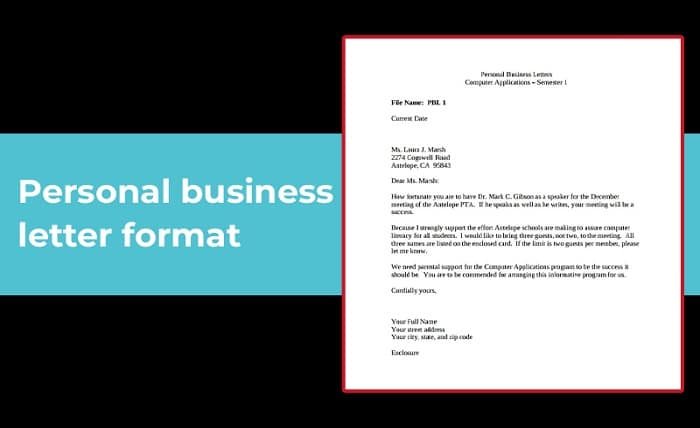In the professional world, effective communication is paramount, and mastering the business letter format is a crucial skill. Whether you’re reaching out to potential clients, addressing grievances, or making formal requests, a well-structured business letter can make a significant impact. This guide delves into the essential components of the business letter format, providing you with the knowledge to create clear, concise, and professional correspondence.
The Importance of Business Letter Format
The business letter format is more than just a template; it’s a reflection of your professionalism and attention to detail. Adhering to a standard buiness time ensures that your message is conveyed clearly and respectfully. It establishes credibility and can influence how your communication is perceived by the recipient. A properly formatted business letter also facilitates easier reading and understanding, which is essential in busy professional settings where time is limited.
Key Components of the Business Letter Format
A standard business letter format includes several key components that work together to create a cohesive and professional document. These components are the heading, date, inside address, salutation, body, closing, and signature. Each element serves a specific purpose and contributes to the overall effectiveness of the letter. Understanding and correctly implementing these components is essential for anyone looking to master the business letter format.
The Heading and Date in Business Letter Format
In the business letter format, the heading and date are placed at the top of the letter. The heading typically includes your company’s name and contact information, while the date indicates when the letter was written. This section sets the stage for the communication, providing the recipient with necessary context. Properly formatting the heading and date ensures that your letter appears organized and professional, which is crucial for making a positive first impression.
Inside Address: The Recipient’s Information
The inside address is a vital part of the business letter format, as it specifies the recipient’s name, title, company, and address. Placing this information correctly ensures that your letter reaches the intended person without delay. It also demonstrates your attention to detail and respect for the recipient. In the business letter format, the inside address is typically aligned to the left and placed below the heading and date, maintaining a clean and professional layout.
Crafting an Effective Salutation
The salutation in the business letter format serves as the greeting to the recipient. It is important to address the recipient correctly, using appropriate titles and names. Common salutations include “Dear Mr. Smith,” or “Dear Dr. Johnson.” An effective salutation sets a respectful tone for the letter and establishes a connection with the reader. Properly using the salutation is a key aspect of the business letter format that contributes to the overall professionalism of your correspondence.
Writing the Body of the Business Letter
The body of the letter is where you convey your message, and its structure is crucial in the business letter format. Typically divided into three paragraphs—introduction, main content, and conclusion—the body should be clear, concise, and well-organized. Each paragraph should serve a specific purpose, ensuring that your message is easily understood. Mastering the body of the business letter format allows you to communicate effectively and achieve your intended goals.
Appropriate Closings for Business Letters
The closing of a business letter is the final opportunity to leave a lasting impression. In the business letter format, common closings include “Sincerely,” “Best regards,” and “Yours faithfully.” The closing should be followed by a comma and then your signature. An appropriate closing reinforces the professionalism of your letter and provides a polite end to your communication. Selecting the right closing is an essential part of the business letter format that enhances the overall tone of your correspondence.
Formatting the Signature in Business Letters
In the business letter format, the signature section follows the closing and includes your handwritten signature (for printed letters) and your typed name. If applicable, you may also include your job title and company name beneath your typed name. Properly formatting the signature ensures that your letter appears complete and professional. It also adds a personal touch, especially in printed letters, reinforcing the authenticity of your communication within the business letter format.
Including Enclosures and CC in Business Letters
Sometimes, your business letter may need to reference additional documents or inform others about the correspondence. In the business letter format, enclosures are noted by the word “Enclosure” or “Enclosures” below the signature, indicating that additional documents are included. Similarly, “CC” (carbon copy) is used to indicate other recipients who will receive the letter. Including these elements correctly ensures that all relevant parties are informed and have access to necessary information, maintaining clarity in the business letter format.
Common Mistakes to Avoid in Business Letter Format
When adhering to the business letter format, it’s important to avoid common mistakes that can undermine your professionalism. These include grammatical errors, incorrect formatting, using inappropriate language, and failing to follow the standard structure. Additionally, neglecting to proofread your letter or omitting essential components can lead to misunderstandings or a negative impression. Being aware of these pitfalls and taking steps to avoid them ensures that your business correspondence remains effective and polished.
Digital vs. Traditional Business Letter Format
With the rise of digital communication, the business letter format has evolved to accommodate both traditional and electronic mediums. While the core elements remain the same, digital business letters may require adjustments such as different alignment for email headers or incorporating digital signatures. Understanding the nuances between digital and traditional business letter format ensures that your correspondence remains professional regardless of the medium used. Adapting to these changes is essential in today’s diverse communication landscape.
Conclusion
Mastering the business letter format is essential for effective professional communication. By understanding and implementing the key components—heading, inside address, salutation, body, closing, and signature—you can craft letters that are clear, concise, and professional. Avoiding common mistakes and adapting to both digital and traditional formats will enhance your ability to communicate effectively in any business setting. Whether you’re writing to clients, colleagues, or stakeholders, a well-formatted business letter can significantly impact your professional relationships and success.
FAQs
1. What is the standard business letter format?
The standard business letter format includes a heading, date, inside address, salutation, body, closing, and signature. Each section serves a specific purpose to ensure clear and professional communication.
2. How do I format the heading in a business letter?
In the business letter format, the heading typically includes your company’s name, address, phone number, and email, aligned to the top left or centered, depending on the style you choose.
3. What salutation should I use in a business letter?
Common salutations in the business letter format include “Dear Mr. Smith,” “Dear Ms. Johnson,” or “Dear Dr. Lee.” Use the appropriate title and last name to maintain professionalism.
4. Can I use a business letter format for emails?
Yes, you can adapt the business letter format for emails. While some elements like the physical signature may change, the overall structure—heading, salutation, body, closing—remains the same to ensure professionalism.
5. What are some common mistakes to avoid in business letter format?
Common mistakes in the business letter format include grammatical errors, incorrect alignment, using informal language, omitting key components, and failing to proofread. Ensuring accuracy and professionalism is crucial.



